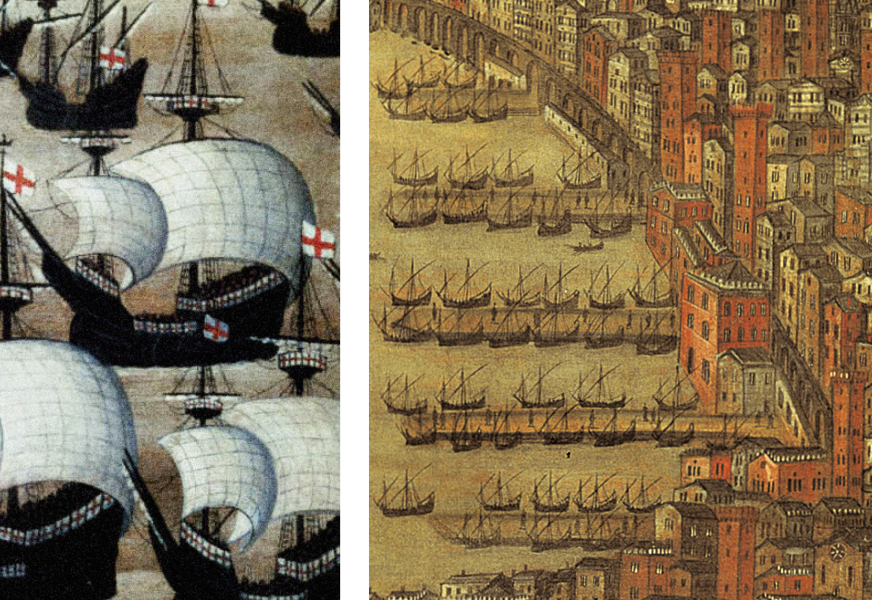Dal Trecento,
oltre Gibilterra

Genova nel 1481: il porticato continuo di Sottoripa con le sue torri, i moli e la parte medioevale di Palazzo San Giorgio rappresentati cento anni dopo da Cristoforo Grassi // Genoa in 1481: the uninterrupted arcade of Sottoripa with its towers, the piers and the medieval part of Palazzo San Giorgio represented one hundred years later by Cristoforo Grassi
Grandi navi, moli in pietra, esplorazioni e colonie
Le imbarcazioni possono ora raggiungere terre lontane e più si fa lungo il viaggio, più diventa necessario modellare nuove forme di carene e di vele a seconda del motivo della spedizione: una nave da guerra leggera e maneggevole ha bisogno di una forma diversa da quella, robusta e capiente, destinata al trasporto delle merci. Le rotte si spingono dal vicino Oriente all’attraversamento dello stretto di Gibilterra, a Occidente.
I genovesi riescono a insediarsi con colonie nel Mar Nero e in tutto il Mediterraneo orientale riuscendo a instaurare accordi mercantili di assoluta eccellenza.
Per garantire questi movimenti, è necessario che il porto sia in grado di ricevere le navi, sempre più ingombranti, e rendere agevole nel limite del possibile il trasferimento delle merci da e per la riva: per più volte, nel secoli, dalla spiaggia si allungano verso il mare, mai abbastanza profondo, moli dapprima di legno, poi di pietra, sui quali si costruiscono fari che col tempo si fanno più alti e più luminosi. La Lanterna è di questi il simbolo più noto.
Dopo l’epidemia mortale della peste, vi è una forte ripresa di natalità che impone che alle cosiddette ‘merci sottili’, preziosissime e poco ingombranti come l’oro, sete e tessuti rari, si preferiscano le ‘merci grosse’ come lana, grano, metalli, sale, che richiedono, per produrre un vero guadagno, di essere trasportate in grandi quantità.
È l’epoca del veneziano Marco Polo che, catturato dai genovesi in battaglia, viene condotto in carcere in prossimità dei moli: a un compagno di prigionia, il pisano Rustichello, racconta dei suoi viaggi in Oriente. È qui che, un secolo dopo, Cristoforo Colombo, quattordicenne, si imbarcherà per seguire gli interessi mercantili di alcune tra le più importanti famiglie nobili genovesi, per poi volgere lo sguardo verso ovest. L’America non sarà solo una novità geografica, ma una rivoluzione economica e di costume.
From the 14th century, to Gibraltar and beyond.
Great Ships, Stone Piers, Explorations and Colonies
Vessels were now able to reach distant lands and the longer the voyage, the more it became necessary to design new types of hulls and sails depending on the reason for the expedition: a light and manoeuvrable warship needed a different design compared to the sturdy and spacious one designed to transport cargo. The routes included the Near East and the crossing of the Strait of Gibraltar to the West. The Genoese successfully established colonies in the Black Sea and throughout the eastern Mediterranean setting up excellent trading agreements.
To guarantee trade operations, the port needed to accommodate increasingly large ships and facilitate the transportation of goods to and from the shore: over the centuries, the piers were repeatedly extended outwards into deeper waters, at first in wood, then in stone, and lighthouses were built, taller and brighter over time. The Lanterna is one of such lighthouses and has become a symbol of the city.
After the deadly plague epidemic, there was a marked increase in births, which meant that so-called ‘fine goods’, precious but not bulky such as gold, silks and rare fabrics, were replaced by large goods such as wool, wheat, metals and salt which needed to be transported in large quantities to yield a real profit.
This was the age of Marco Polo, the Venetian who, captured in battle by the Genoese, was imprisoned near the docks: there he told a fellow prisoner, Rustichello from Pisa, about his travels to the East. It was again here, a century later, that 14-year-old Christopher Columbus embarked to follow the commercial interests of some of the most important noble Genoese families, before setting his eyes on the west. The Americas would turn out to be not only a geographic discovery, but a true revolution for the economy and the customs of the time.
